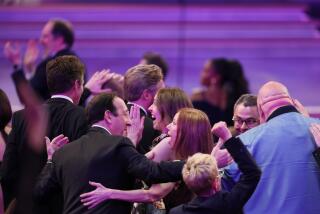AdClub Taps Its Own Stars With Awards
The 1986 Orange County AdClub AdAwards, the 20th such celebration, reflected some of the glitter of an Academy Awards presentation Tuesday night at the Disneyland Hotel. “Reach for the Stars” was the theme of the prestigious event; movie star look-alikes wandered about, and a real movie star, Cornel Wilde, was the emcee.
The evening’s top honor, the Sweepstakes Award, went to Salvati Montgomery Sakoda Inc. of Santa Ana. Forty Golden Orange (first place) Awards, 15 Special Judges’ Awards and 94 Certificates of Merit were also presented in various categories of television, radio and printed materials, including magazines, newspapers, direct mailings and community service.
Among the attention-getting entries on display during the cocktail reception:
- A “Buttons for Bozos” headline promoting an easy-to-use telephone.
- Frankenstein providing the backdrop for “Sometimes electrodes can be a pain in the neck,” in an ad for analytical electrical instruments.
- For a tax attorney firm: “Dear God, get me out of this one and I promise I’ll never cheat the IRS again.”
- For childbirth and child-care classes, a crying baby beneath which is written: “Instructions not included.”
According to Judi Lee Cabrera, AdAwards chairwoman and vice president of the Disneyland Hotel, past events attracted a maximum of 500. This year, 950 advertising agency owners, creative directors, copywriters, clients and judges attended. In all, 150 of more than 700 entries were deemed winners by the judges, who were all from Los Angeles. “We want them to be impartial,” Cabrera explained.
Agencies Like Awards
The agencies consider the awards a highly esteemed measure of respect from their peers; awards can be used as promotional tools for the advertising companies or simply to reinforce existing clients’ faith.
Judge Steve Hollingsworth talked about the nature of advertising and some current directions.
“Advertising has a lot to do with style,” he reflected. “It’s communication. It’s you listening to me. It’s not me talking to you.
“There are some graphic trends, the way things are looking. Things are getting very simple. Minimal imagery, minimal copy. The Nike billboards, for instance, don’t have any copy, just a little Nike label. A lot of us are moving toward that.
“People in advertising also seem to have discovered right brain, left brain. Ideally, you want to appeal to both sides. But the emphasis today really seems to be on the emotional aspect--we’ve learned that purchasing decisions are made in the emotions.”
Past AdClub president Jack Mealer of Huntington Beach, who helped provide the judges with guidelines, noticed other recent trends in advertising art.
“You see it in the way a photograph or an illustration is done,” Mealer said. “It’s more a feeling than something that can be articulated, a feeling of high tech, a stark look. The British set the trend about two years ago.
“Otherwise, it’s just the product presented in a good, bold, aggressive way, with some human appeal, humor, some tongue-in-cheek if you will, to bring people into the ad.”
Soft touch, hard sell?
“I’d say most people here would endorse that.”
The Sweepstakes Award-winning entry was a direct mail campaign series of three for manufacturers of a residential security system. The first in the series shows newspapers piled on a front porch welcome mat with the words: “Good news for burglars.” A lit porch light illustrates the cover of the second mailer: “At night it attracts moths. In the day it attracts burglars.” Inside copy begins: “The lights are on but nobody’s home.”
Mark Doyle of Lake Forest is a copywriter for the agency that came up with an ad for yogurt which begins, “Stop eating yogurt.” (It’s an ad for liquid yogurt.) He agreed that less is more at the moment.
“Studies show that people don’t often read all the copy, so you try to keep it short,” Doyle explained. “There are exceptions, of course, some very successful ads that have very long copy--the BMW and Mercedes ads, for instance. Cars seem to be able to get away with it.”
But he emphasized that the less-is-more approach hasn’t meant any less work for copy writers.
“In fact, it takes a lot longer to write a short ad,” he said. “Quite often, I’ll rewrite an ad seven times, and it gets shorter each time. The first write can be twice as long as the last.
“In any case, the business has essentially changed little over the past 10 years. The same craftsmanship is involved: You do the copy points for the client, you strive for a sense of style for yourself so it will come off as a nice piece of writing, a little piece of literature.”
More to Read
The biggest entertainment stories
Get our big stories about Hollywood, film, television, music, arts, culture and more right in your inbox as soon as they publish.
You may occasionally receive promotional content from the Los Angeles Times.










